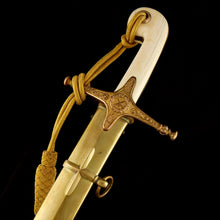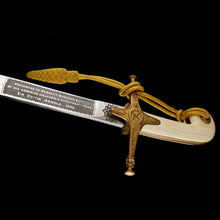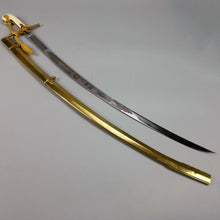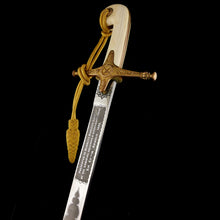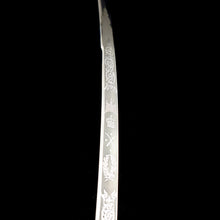Presentation Mameluke Sword to a Celebrated War Correspondent, 1899
- Regular price
- £3,800
- Sale price
- £3,800
- Regular price
-
- Unit price
- /per
Adding product to your cart
Length overall: 98cm (39in)
Steel, ivory, brass. A General Officer’s pattern mameluke sword commissioned by Sir Edwin Arnold (1832-1935), the Daily Telegraph’s editor-in-chief from 1873 to 1889, for presentation to the paper’s star war reporter. Curved blade double-edged at the clipped-back point and etched over much of its length on both sides with symmetrical scrolling foliage, crossed branches of oak and laurel, crossed sword and baton, and crowned 'VR' cypher. The blade inscribed ‘Presented to Bennett Burleigh Esqr / by his admiring colleague & affectionate friend / Sir Edwin Arnold, 1899’. Maker’s mark of Henry Wilkinson, Pall Mall, London, beneath the Royal warrant of the Prince of Wales. The hilt with gilt guard cast and chased on both sides with foliage centred on a crossed sword and baton within a wreath, the handle with ivory grips. Contained in brass scabbard. Blade: 78 cm (30.7in).
This item is offered for sale in compliance with the Government ivory exemption permit: Submission reference 3GSD88RD.
Read more
Bennet Burleigh was quite simply the most famous war correspondent of his day. A larger than life exponent of the jingo-journalism so beloved of Victorians, he covered some 24 campaigns for the Daily Telegraph, which he joined in 1881 to report on the Mahdist War in Sudan. Over the next 33 years, he covered conflicts from around the globe, filing reports from Asia, Africa and Europe. His scoop on the fall of Khartoum and the death of General Gordon prompted the printing of the Daily Telegraph on a Sunday. Brave, resourceful and good with languages, Burleigh was not beyond the use of underhand tactics in the pursuit of a scoop. Indeed it was his instinctive resourcefulness that aided his escape from jail in earlier life on two occasions during the American Civil War.

Burleigh’s success owed much to the editorial talents of Sir Edwin Arnold (1832-1935) who joined the Daily Telegraph staff in 1861. He became chief editor in 1873, a post he held until 1889. After Oxford University, he spent time teaching in India before joining The Telegraph, where he worked for more than 40 years. He is remembered for arranging the Stanley expedition with the New York Herald, and as the author a million-copy bestseller ‘The Light of Asia’ which introduced Buddhism to western audiences.
Bennet Burleigh (1840-1914) was born in Glasgow and began his working life as shipping clerk. Following a shotgun wedding to a housemaid, he went to America with plans for a submarine that he wanted to present to the Confederate States Navy. The Confederates demurred and he joined the privateer John Yates Beall as the second-in-command of two ships operating on the Potomac and in Chesapeake Bay where he planned and executed the capture of a Federal steamer, whose flag was later publicly displayed at Richmond, Virginia.
In May 1864 Burleigh was wounded and captured by the 36th US Colored Infantry during raid on Union lines and incarcerated at Fort Delaware. Here he managed to pry up several floorboards and escaped with five others through a sewer. At the mouth of the sewer two of his companions were captured; two others were drowned in the Delaware. Burleigh himself swam five hours in the darkness until finally was picked up by a vessel whose commander he convinced he had fallen overboard while fishing. Making his way to Canada he again fell in with Beall and they plotted a mass breakout of some 2000 Confederate prisoners of war held at Johnson’s Island, Lake Erie. Taking passage in a small steamer out of Detroit, they hijacked the vessel and seized another before betrayal forced them to make for the Canadian shore and discreetly disappear. Rewards were placed upon their heads and Burleigh was apprehended and extradited to Detroit. Nine months in jail and an inconclusive court case later, Burleigh determined his own fate by escaping back to Canada.
With the Civil War at an end, Burleigh made his way to Texas, where he worked as an editor on the Houston Telegraph followed by a stint in on a paper in Brooklyn, New York. Having officially changed his name from Burley to Burleigh, he returned to Britain in 1878 and landed a job in Egypt with the Central News Agency. His reporting on the bombardment of Alexandria in 1882 attracted the attention of The Daily Telegraph with which he was to be associated for the rest of his working life. He covered the Battle of Kassassin and achieved a notable scoop on the capture of Cairo.
In February 1884 he accompanied the Suakin Expedition of 3000 men under Sir Gerald Graham, VC, which destroyed the military power of the slave trafficker and Mahdist Osman Digna on the Red Sea coast after his slaughter of Valentine Baker’s 3500-strong Egyptian gendarmerie at El Teb. Advancing in land with the in square formation and witnessing the fighting first hand - ‘almost a melee of bayonets against spears’ - Burleigh was again first to get the news out after a dangerous night ride to the telegraph station at Suakin. Rejoining the advance, Burleigh was next present at the Battle of Tamai where the square broke and the reporter found himself in the thick of it and having to help rally the York & Lancasters as they were hurled back by insanely brave bullet riddled Dervishes, into the groups of desperately fighting Highlanders, Bluejackets and Marines.
In 1885 Burleigh was with the desperate camel borne dash across the Bayuda Desert to reach Gordon at Khartoum before the city fell to the Mahdi. En route he was present at the Battle of Abu Klea and was close to the Victorian hero Colonel Fred Burnaby when he was fatally speared through the throat while engaged in single combat outside the square. Two of Burleigh’s press colleagues were also killed, John Cameron of the Standard and St. Leger Herbert of the Morning Post. Burleigh shocked at least one army officer by suggesting the removal of Herbert’s relatively new boots for his own use (which, post burial, he did). Two days later Burleigh was himself wounded in the Battle of Abu Kru, after which and advance party made a bid by Nile steamer to reach Gordon. With their return and another of Burleigh’s gallops across the desert, he obtained the scoop, thirty-six hours ahead of official confirmation of Gordon’s death and the slaughter of the Khartoum garrison - causing the Telegraph to take the unprecedented step of issuing a Sunday edition.
A decade or more later and acting on a tip-off that Herbert Kitchener was about to retake Khartoum, Burleigh set out on a hazardous and unsupported journey into the heart of Mahdist territory. It was a mission that no European had attempted for 14 years and one that tested to the full Burleigh’s exceptional endurance disregard of danger, and knack of picking up dialects and languages. Then within days of his return to London he started again for Egypt and the Sudan to report the actual campaign of reconquest. Owing to the death of the Times correspondent at the Battle of Omdurman and by Burleigh’s characteristic habit of stealing a march on his rivals, news of Kitchener’s victory was published in London before the official despatches were in the hands of the War Office printers.
At the height of his reputation Burleigh reported the 1899 South African crisis and the opening Natal battles of the South African War. When Sir George White withdrew into Ladysmith and the siege was imminent the other correspondents decided to remain there. Burleigh, knowing he could report more elsewhere, left. He reported Sir Redvers Buller's campaign until after the failure at Vaal Krantz in February 1900, then Roberts's offensive and later the guerrilla war. In his reporting he included—insofar as the censor permitted or could be evaded—criticism of the War Office, and British generalship, tactics, and matériel. He emphasized the horror of Spion Kop and demanded an inquiry into the disaster. His final forays were reporting the war in Somaliland against Muhammad bin Abdullah, the ‘Mad Mullah’; Russo-Japanese War (1904); and the Balkans. He took an interest in politics and despite his employment with the Telegraph, professed to be a radical socialist. He stood unsuccessfully for parliament three times but once gained admittance to the lobby of the House of Commons as a reporter by disguising himself as a gas fitter. At his death in 1914 the Telegraph gave him a full page obituary and funds were raised for a memorial in the crypt of St Paul’s Cathedral. George V asked Winston Churchill to chair a committee tasked with commissioning a statue in Burleigh’s memory, yet the statue was never executed owing to the outbreak of the First World War.








